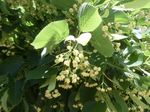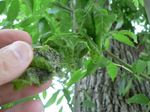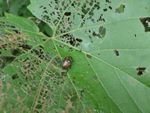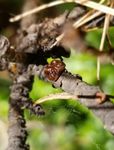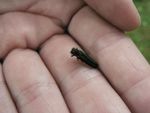Tree Pest Alert - SDSU Extension
←
→
Page content transcription
If your browser does not render page correctly, please read the page content below
Tree Pest Alert
June 23, 2021 Volume 19, Number 19
In This Issue Plant development for the growing
Plant Development .................................................................... 1
Treatments to begin now........................................................... 1
season
Timely topic ............................................................................... 2
We are at about 995 growing degree days (GDD-base
Emerald ash borer update ..................................................... 2
Emerald ash borer progress in Canton.................................. 2 50) in Sioux Falls. The lindens are in bloom across much
Japanese beetles out in Sioux Falls ...................................... 3 of the state and their honey scented flower are adding a
E-samples ................................................................................. 3 nice fragrance to the air. The flowering is just slightly
Ash leaf curl aphid ................................................................. 3 ahead of schedule, but not by much.
Pine tortoise scale ................................................................. 3
Samples received/site visits ...................................................... 4
Minnehaha County (possible herbicide drift on ash) ............. 4
Minnehaha County (pine wilt disease on Austrian pines) ...... 4
Union County (cottonwood petiole gall) ................................. 5
Yankton County (fireblight on pear) ....................................... 5
Samples
John Ball, Professor, SDSU Extension Forestry Specialist & South
Dakota Department of Agriculture and Natural Resources (SDDANR)
Forest Health Specialist
Email: john.ball@sdstate.edu
Phone: 605-688-4737 (office), 605-695-2503 (cell)
Samples sent to: John Ball
Agronomy, Horticulture and Plant Science Department Rm 314, Berg
Agricultural Hall, Box 2207A
South Dakota State University Treatments to Begin Now
Brookings, SD 57007-0996 Apple maggot (Rhagoletis pomonella) is our
Note: samples containing living tissue may only be accepted from most serious apple pest and treatments start
South Dakota. Please do not send samples of plants or insects from
other states. If you live outside of South Dakota and have a question, now!
please send a digital picture of the pest or problem.
Symptoms of an apple maggot infestation are a dimpled,
Any treatment recommendations, including those identifying specific
pesticides, are for the convenience of the reader. Pesticides mentioned
lumpy appearance to the surface of the apple and the
in this publication are generally those that are most commonly flesh often turning mushy. Inside, the apple will contain
available to the public in South Dakota and the inclusion of a product the brown trails of the larvae, hence the other common
shall not be taken as an endorsement or the exclusion a criticism name “railroad worms.” A sure sign of the pest – an
regarding effectiveness. Please read and follow all label instructions as
the label is the final authority for a product’s use on a pest or plant.
unpleasant one if you happen to find one, or half of one,
Products requiring a commercial pesticide license are occasionally while eating the apple – is a small (1/4”), creamy white
mentioned if there are limited options available. These products will be and legless larva in the fruit. The adults, resembling
identified as such, but it is the reader’s responsibility to determine if houseflies with banded wings, are beginning to fly and
they can legally apply any products identified in this publication.
depositing eggs on the developing apples.
Reviewed by Master Gardeners: Bess Pallares, Carrie Moore, and
Dawnee Lebeau Once adult emergence from the soil begins (900 GDD),
The South Dakota Department of Agriculture and South Dakota State egg-laying on apples will start and continue for about a
University are recipients of Federal funds. In accordance with Federal month. The larvae burrow immediately into the apple
law and U.S. Department of Agriculture policy, this institution is and feed for several weeks or more before dropping to
prohibited from discriminating based on race, color, national origin,
the ground (usually in the infested apple). The apple
sex, age, or disability (Not all prohibited bases apply to all programs.)
To file a complaint of discrimination, write USDA, Director, Office of maggot pupates in the soil and remains there until now.
Civil Rights, Room 326-W, Whitten Building, 1400 Independence
Avenue, SW Washington, DC 20250-9410, or call (202) 720-5964 Treatment is either Carbaryl (Sevin) or Malathion applied
(voice and TDD). USDA is an equal opportunity provider and employer. starting now with subsequent applications every 7 to 10
This publication made possible through a grant from the USDA Forest days for three or four more applications. Apple maggots
Service. tend to emerge from the soil after a 1/2-inch rains so
some producers time applications with rainfall, but this is
not necessary for the home production (and we would be
lucky to get a 1/2-inch rain!).
1Another means of management is to place 3-inch be folded beneath two long covers called elytra. These
diameter bright red balls in the tree, about two in semi wing covers are a duller and darker green.
dwarf trees (about 10-15 feet tall) and five in standard
size trees (about 20-30 feet tall). Each ball is covered They can move very quickly so do not expect them to
with a sticky material called Tanglefoot®. hang around long enough for a selfie.
The female apple maggot always flies to the biggest, Emerald ash borer progress in Canton
brightest apple to lay her eggs and these balls will be the
biggest, brightest “apples” in the tree. You cannot The one year change in the ash tree canopy in Canton
eliminate the pest by using this control, but the due to emerald ash borer is very noticeable. While last
population can be significantly reduced. The “apples” June you had to look closely to see the tell-tale signs of
can be made from material found in almost any garden an infested trees (thinning upper canopy, clusters of
store. Tanglefoot® can be found at most hardware shoots and leaves in the lower canopy), now these trees
stores. You can buy the completed “apples” from several are appearing throughout the town. This is consistent
companies on the Internet. with experience in other small towns throughout the
Midwest. Once the beetle is confirmed in a small
Another control measure is to spray Kaolin clay on the community, the infestation becomes widespread within
fruit. The clay is not a true pesticide, but it irritates the three years or so.
adult apple maggot, and they fly to other fruit. The clay
must be reapplied if we have some heavy rains. Many
summers you can expect to make several applications
during season. It may not require as many this dry
summer. The clay is sold as ‘Surround At Home®.
Timely Topics
Emerald ash borer update
The adult emergence is almost at peak emergence. It
seems to coincide with the full bloom on lindens which
we are beginning to see across the state. If anyone is
looking to see an emerald ash borer adult, now is the
time to be out hunting.
They are also likely to be disappointed. The adults are
This is not the case for larger cities such as Sioux Falls
typically out in the middle of the day when the air
where there are lots of ash to absorb the expanding
temperatures are in the 70s and 80s. Once it gets hotter,
populations so the spread throughout the town is slower.
they are less active (just like us).
It has been three years since the confirmation of
They are most likely to be seen in the upper canopies of emerald ash borer in Sioux Falls and while I can find
ash, not a spot that most people have access. The infested trees throughout the town now, they are in
chances of finding one along a lower branch or trunk are groupings rather than widespread.
very slim. And do not expect them to land on your hand.
Still the number of lightly infested ash throughout Sioux
Falls is growing and I expect the infestation to be more
noticeable by 2022-2023, just as we predicted back in
2018.
Fortunately, there are two big factors that are dampening
the impact of emerald ash borer in Sioux Falls. First, the
city began an ambitious program to remove street and
park ash trees over a 10-year period. The removals have
been targeted and throughout the community, so the
loss is not as noticeable. This process will gradually thin
ash out of neighborhoods.
Second, the residents of Sioux Falls have also been
removing ash trees and, equally important, treating
desirable ash trees. Sioux Falls has one of the highest
But just in case, here is what to look for. The adults are a treatments rates in the country. And just as herd
coppery-green and about 1/2-inch long. They are very immunity is an important strategy for COVID, it may also
slender; only about 1/16-inch wide. They are usually be helpful in slowing the spread of emerald ash borer in
found walking or resting on the bark so their wings will the community.
2The more trees that are treated, the more likely an adult The most common treatments to kill the adults are foliar
emerald ash borer will encounter a tree with toxic leaves sprays of insecticides labelled for control of Japanese
when they are feeding. That means fewer adults to lay beetles and containing Acephate or Carbary as the
eggs on nearby trees. active ingredient. A soil drench of an insecticide
containing Imidacloprid may also be used but must be
Japanese beetles are out in Sioux Falls applied in the spring before adults are begin feeding as it
takes a while to concentrate in the leaves. Caution – do
Rick, our South Dakota Department of Agriculture and not apply imidacloprid to plants with flowers attractive to
Natural Resources (SDDANR) forester located in Sioux bees. These include crabapples, lindens, and roses.
Falls emailed me that he is beginning to see adult
Japanese beetles. The adults begin appearing at about Neem, a plant-based insecticide, is another choice,
970 GDD. The beetles are right on schedule. particularly when there is a concern for harming
pollinators. Neem products that contain Azadirchtin are
Japanese beetles have been spreading across the state effective at deterring feeding for about three to four days.
for almost a decade now. They entered the United This means frequent applications and you will still see
States in 1916 through New Jersey, so we had about a some buzzing around (but hungry). However, neem
century to prepare for it! products that do not contain azadirachtin, are not
effective. These products are usually sold as neem oil
There is nothing nice about having this insect come visit
but always check the label.
South Dakota – though maybe it liked our South Dakota
“Better than Mars” campaign to get folks to come to visit.
After all, having a breathable atmosphere is a basic
E-samples
requirement for this insect. Ash leaf curl aphid on tips of ash shoots
The insect also likes a lot of the plants we have here. The ash leaf curl aphid also known as the woolly ash
The larvae, which feed in the soil, feed on grass roots aphid (Prociphilus fraxinifolii), is showing up across the
and can destroy a lawn. The adults, which are beginning state as it frequently does about this time each summer.
to emerge now, have a wide host range and while roses, The symptoms are curled leaves forming rosettes at the
lindens, and hydrangeas are among their favorites, they ends of ash shoots, especially the rapid growing terminal
feed on about 300 other plants including soybean leave shoots. If you unfolded these curled leaves, you find
and even corn silks! these little “fuzzballs” that are aphids (and they move
very quickly once you open the leaflet they are in).
The adult Japanese beetles are 7/16-inch long, metallic
green beetles with copper-brown wing covers. They
have a row of white tufts of hairs just beneath the edge
of the wing covers on each side.
Treatment is usually either letting them be – since any
treatment will not uncurl the leaves and lady beetles do a
pretty good job of control – or a soil injection of an
You can find them feeding in colonies on bright, sunny insecticide containing Acephate or a trunk spray of
days on linden leaves (as well as other plants) and rose Dinotefuran. These work as a systemic and will kill the
petals. They feed on the upper surface of the leaves, aphids as they feed on the leaves (but this should be
munching on the foliage between the veins so the done in early spring, just after the leaves open). Most
devoured leaf has a lace-like appearance. The females foliage applied insecticides are contact poisons and will
stop snacking to occasionally fly to the ground and not reach the aphids living inside the curls.
burrow into the soil to lay eggs.
Pine tortoise scale
The adults live for about a month. July is month where
we see most of these beetles and by the end of August Pine tortoise scale (Toumeyella parvicornis) is a
they are gone. common scale on many of our mugo pines, but I also
3see them on Scotch pine. Rick, the SDDANR forester in common symptoms are curling of petioles and cupping
Sioux Falls, sent this picture of one on a Scotch pine. of the leaflet blades. There are also many ashes
presenting strapping – a stretching of the leaflet blades.
The insect gets its name from the tortoise-like shell that
These are common symptoms associated with exposure
covers the adult female. The shells are reddish-brown
to growth regulator herbicides such as 2,4-D and
and slightly wrinkled. The females are the overwintering
dicamba. We are conducting tissue analysis to look for
stage, and the females resume growth in the spring,
residue in the leaves.
maturing in June.
The eggs – as many as 500 per mom – are laid under Minnehaha County, Pine wilt disease in
the shell. Egg hatch begins at about 500 GDD and the Austrian pine
young, called crawlers, come out beneath the now dead
mom to move out to the new shoots and suck sap. Egg This was a call about dying ponderosa. When I looked at
hatch ends at 1,200 GDD so we have a lot of young the trees, the grove of trees were not ponderosa pines
crawlers still scampering around the twigs looks for a but Austrian pines. An easy way to separate the two
place to insert their mouthparts and begin sucking sap. species is that ponderosa pine will usually have longer
needles, 5 to 11 inches long, versus 4 to 6 inches long
The insects produce honeydew from their feeding and for Austrian pine. Ponderosa pines will also usually have
this sticky material will often coat the needles and the needles in clusters (fascicles) of 2’s and 3’s while
shoots. The honeydew is also a food source for a sooty Austrian pine is always in 2’s.
mold fungus, and this coats the needles and twigs with a
powdery substance. The trees were almost completely dead with gray
needles hanging from twigs so dry they snapped easily
The best time to treat to suppress the population (you in your hand. The nearby Scotch pines were presenting
cannot eliminate them) is now. The treatment can be a the same symptoms. The problem was pine wilt disease,
simple as forceful sprays of water (two times 5 days apart) a disease that has frequently appeared in the Pest Alert
to dislodge the crawlers from the plant to insecticides to this year.
kill them as they feed or crawl along the twig.
The most common insecticides used for control contain
Acephate, Dinotefuran or Imidacloprid as the active
ingredient (and they must be labeled for scale control on
pine). These are best applied as a soil injection rather
than a spray as many insecticides sprayed on the shoots
kill far more than the scale (including insects that feed on
the scales) Horticulturall oils are often listed as an option,
and these are much less harmful to other insects.
However, these should not be applied in hot weather and
that seems to be all we have this year!
Samples received/Site visits
Minnehaha County, Possible herbicide drift
on ash
While the disease - caused by a nematode but carried
I have been receiving numerous calls concerning from tree to tree by a longhorned beetle – is now found
herbicide drift. There has been a noticeable increase throughout the state, the southeastern counties are
from last year. One of the most common trees that being especially impacted with rows of dead Austrian
seems to be affected is the green ash. The most
4and Scotch pines windbreaks dotting acreages and such as cherries, plums, and peaches. Fireblight is also
yards. a common disease on a popular hedge shrub known as
hedge cotoneaster.
The most common control is to remove and destroy the
infected trees. This is usually accomplished by burning
in the winter as the longhorned beetle move the
nematode from now dead hosts to new live ones in the
spring. This only slows the spread and eventually the
entire row or grouping of pines is killed. Our native
ponderosa pine is not affected by pine wilt.
Union County, cottonwood petiole gall
Just about every year I receive calls about fallen
cottonwood leaves with “bumps” at their base. The first
one for this year was from Union County.
Management of affected trees is usually done by pruning
This is the cottonwood petiole gall formed by the feed out the infected tissue before the disease spread farther
activity of a very small green aphid known as (you into the plant. The pruning is performed during the winter
guessed it!) the cottonwood petiolegall aphid while the bacteria is dormant. There is less change of
(Pemphigus spp). The insects begin feeding on the spreading the disease via the pruning tools during that
leaves in the spring and the galls forms around them. time of year.
The aphids usually mature by July and the winged adults
emerge from the galls and fly to another host. The Summer pruning can also be done during dry weather,
alternate host is a plant that is a member of the mustard and we have plenty of dry weather this year. If pruning is
family. The aphid feeds on the roots. performed now to remove the infected tissue, the
pruning cuts need to be made about a foot beyond
The cottonwood damage from this insect is annoying to visible symptoms (blackening wrinkling bark) on the
us – who wants to rake in July – but it does not harm the branches and shoots. The disease often extends farther
tree. The fallen leaves do not need to be burned; the into the tissue than is visible.
insect has already left, so leaving these leaves will not
increase the problem next year. The pruning tools, hand pruners and hand saws, need to
be disinfected between cuts as the disease can be
An application of dormant oil can be applied on the tree transmitted on the small debris caught on or in them. A
to kill the aphids before they move out from the bark 20% solution (1:5 dilution) of Lysol or Pinesol and water
fissures next April. Most people do not bother with can be used. Leave the tools in contact with this solution
spraying, just raking. for 1 to 3 minutes before using them for the next cut.
Household bleach can be used as a disinfectant, but will
Yankton County, Fireblight on pear may corrode pruners.
A dying pear tree was the concern here. The pear (they
could not remember the cultivar, but they said the fruit
was tasty), was presenting with long shoot and branches
that appeared scorched with blacked leaves hanging
from them.
This is the bacterial disease known as fireblight. It is a
common problem with many pear cultivars but can also
be found on apple. It does not affect our stone fruits
5You can also read





